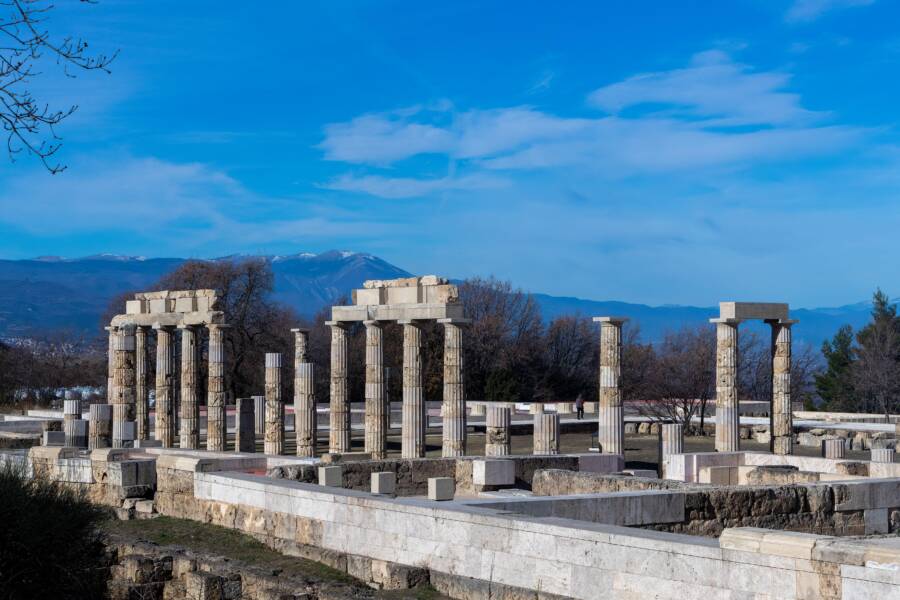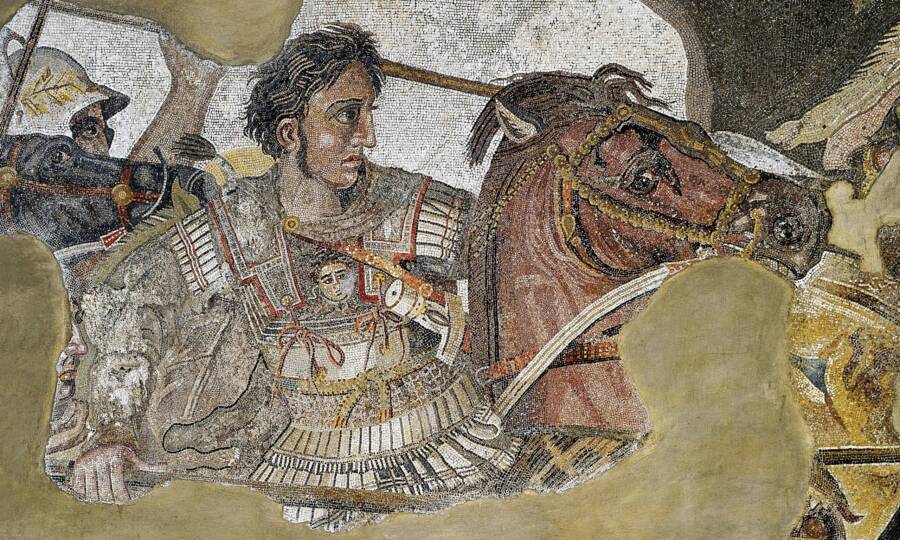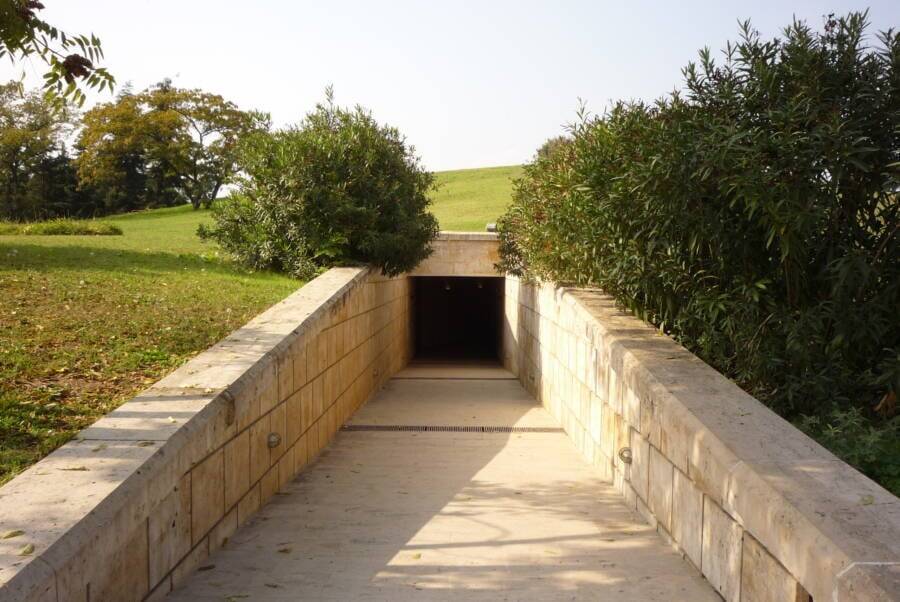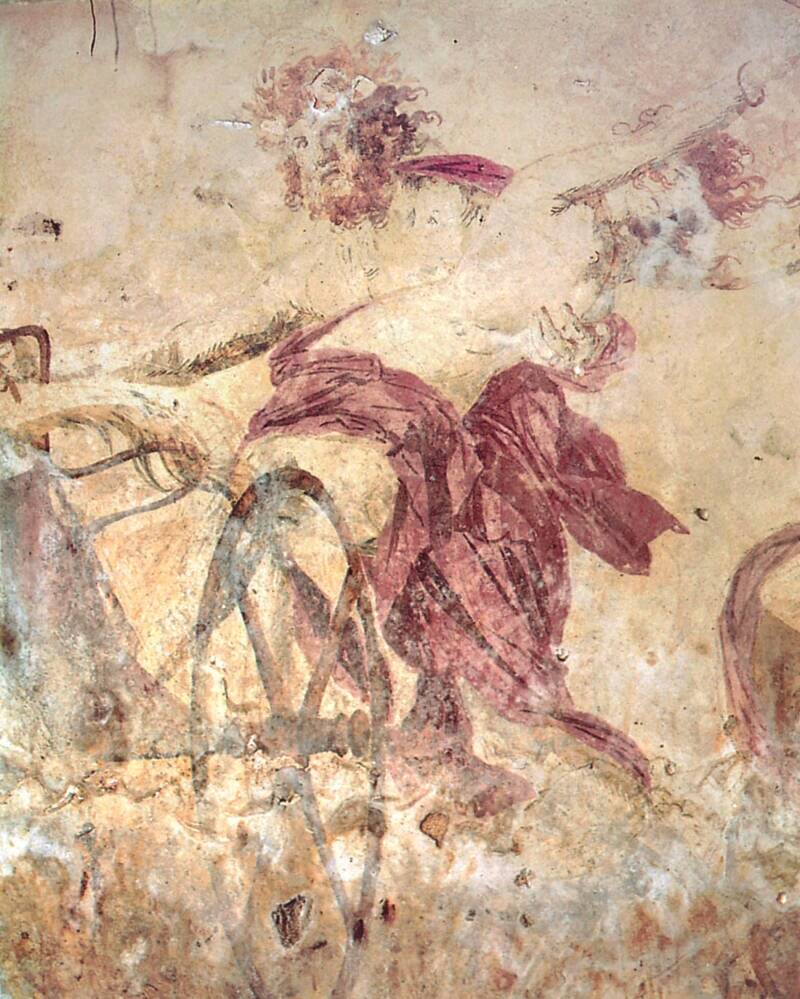Verginia is a small town in Greece today, but it was once famous in the ancient world as Aigai, the royal capital of the Macedonian kingdom.

VASILIS VERVERIDIS/Alamy Stock PhotoThe 2,300-year-old Palace of Aigai in Vergina, Greece, where Alexander the Great was crowned king of Macedonia.
Today, the town of Vergina is a quiet, unassuming place, despite the remarkable ancient monuments scattered nearby. Tucked into a quiet region of Greece, it has a population of just over 1,000 people. But Vergina, once known as Aigai, played a massive role in the ancient world.
Then, it was the royal capital of the ancient kingdom of Macedonia. It was in Aigai that King Philip II of Macedon was assassinated in 336 B.C.E., launching the reign of his son, Alexander the Great. And it’s in the modern-day town of Vergina that archaeologists have uncovered multiple elaborate royal tombs, thought to belong to Alexander the Great’s family members.
Though it’s not as well known as other cities from antiquity, Vergina’s ties to the ancient world make it one of history’s most important places.
The History Of Aigai In Antiquity
The history of Vergina — known in ancient times as Aigai or Aegae — stretches back thousands of years. Originally a collection of villages, its historical significance was established in the 7th century B.C.E., with the arrival of Perdiccas I. Said to be a descendant of Hercules, Perdiccas I became the king of the ancient kingdom of Macedon, or Macedonia.
Aigai subsequently became the center of the Argead dynasty, also known as the Temenids. The descendants of Perdiccas ruled over Macedonia for the next three-and-a-half centuries, which led to the reign of King Philip II.
After Philip was assassinated by one of his own bodyguards in 336 B.C.E. in Aigai, power went to his son Alexander, better known today as Alexander the Great. Possibly due to the urging of his mother, Olympias, Alexander set out to fulfill his father’s dream of conquering the Persian Empire. After consolidating his power by gaining the support of the Macedonian army and forcing Greek city states to accept his reign, he conquered great swaths of the ancient world, from Macedonia and Greece to Egypt and parts of India.

Public DomainA mosaic depicting Alexander the Great, king of Macedonia and one of the great conquerors of the ancient world.
But Alexander the Great died mysteriously at the age of just 32 in 323 B.C.E., and the Argead dynasty did not last much longer. It ended with the murder of Alexander the Great’s son and heir, Alexander IV, in 310 or 309 B.C.E.
In the years that followed, Aigai, the seat of Macedonian kings, suffered greatly. The town was partially destroyed by the Romans in 168 B.C.E., and a 1st century C.E. landslide buried the rest of it in mud and dirt.
It wasn’t until the 20th century that the world realized the true significance of the ancient site in Greece, by the modern-day town of Vergina.
The Discovery Of The Royal Tombs Of Aigai

Panegyrics of Granovetter (Sarah Murray)/Wikimedia CommonsThe facade of a royal Macedonian tomb in Vergina, which is believed to hold members of Alexander the Great’s family.
The modern-day town of Vergina was established in the 1920s, and spent most of the early and mid-20th century as a small, quiet outpost in northern Greece, even though remains of the ancient city of Aigai had been discovered starting in the 19th century. Its reputation dramatically transformed in 1977, when Greek archaeologist Manolis Andronikos made an astounding find.
While working with a team from the Aristotle University of Thessaloniki, Andronikos discovered multiple elaborate ancient tombs. According to a 2024 article from the GreekReporter, Andronikos had made many discoveries in his decades as an archaeologist, but nothing like this.
Eventually, four of these opulent tombs were uncovered at the site, which have since been labeled Tomb I, II, III, and IV. Filled with gold, silver, bronze, iron, frescoes, and human remains, the tombs dated back to the 4th century B.C.E. Ivory busts found within the tombs bore a resemblance to portraits of Philip II and Alexander the Great — which led Andronikos to determine that the Vergina tombs held members of Alexander the Great’s family.

DocWoKav/Wikimedia CommonsSome of the ornate treasures that have been recovered from the Vergina tombs.
Though the location of Alexander the Great’s tomb remains a mystery — his remains were reportedly last seen in Alexandria, Egypt, in antiquity — many other historians believe that the tombs of Vergina hold several of Alexander the Great’s relatives. Many have suspected that the tombs in Vergina contain Alexander the Great’s father, King Philip II; Alexander’s older half-brother, Philip III Arrhidaeus; and Alexander’s son, Alexander IV.
However, figuring out which royal tomb contains which relative has proven to be a headache for many modern-day historians.
The Mystery Of Vergina’s Macedonian Tombs
After the Macedonian tombs were first uncovered in Vergina in 1977, historians labeled them as Tomb I, II, III, and IV. Historians initially speculated that Philip II, the father of Alexander the Great, was in Tomb II.
However, dueling studies have debated this conclusion in recent years.

Colin W./Wikimedia CommonsThe entrance to the royal tombs in Vergina, Greece.
At the end of 2023, a study published in the Journal of Archaeological Science: Reports challenged the historians’ original assumption about the Vergina tombs. The researchers who conducted the study claimed that Philip II was not in Tomb II, but in Tomb I (which had been looted), and that Tomb II contained Philip III Arrhidaeus, the half-brother of Alexander the Great.
(The study did support the traditional narrative that Tomb III belonged to Alexander IV, the son of Alexander the Great, and that Tomb IV belonged to King Cassander, who fought over Alexander’s empire after his demise.)
The study’s authors claimed that the skeleton in Tomb I had physical characteristics that matched up with Philip II. Philip II was said to be lame, and the skeleton in Tomb I appeared to have a knee fusion. Philip II also had a famous eye injury caused by an arrow during the siege of Methoni, and while it was initially thought that the skeleton in Tomb II had a similar injury, many adherents of this hypothesis have refuted their original thoughts.
However, a more recent study published in 2025 in the Journal of Archaeological Science pushed back against this assumption. The researchers claimed that Tomb I, known for its elaborate mural of Hades abducting Persephone, did not contain the remains of Philip II, but a young couple who had lived sometime between 388 and 356 B.C.E. The tomb contained a man who had died between the ages of 25 and 35 and a woman who had perished between the ages of 18 and 25.
Philip II could not be in the tomb, they argued, because he had been assassinated in 336 B.C.E. when he was around the age of 46.

Public DomainThe famous mural from Tomb I that depicts the abduction of Persephone by Hades.
“The fact that Tomb I is clearly not the resting place of Philip and his wife Cleopatra reemphasizes the initial assumptions that Philip II is buried in Tomb II,” study lead author Yannis Maniatis explained to All That’s Interesting. He continued: “[W]e cannot answer this question with scientific certainty but, we may say that since it is now clear that he is not buried in Tomb I, his resting place should be Tomb II, a few meters away from Tomb I.”
As such, some questions about the royal tombs still remain. But their discovery cemented Vergina’s significant place in ancient history. In Aigai, Alexander the Great was crowned king after his father’s sudden assassination — and he then went on to conquer much of the ancient world.
After reading about the long and ancient history of Vergina, discover the story of Alexander the Great and the Gordian Knot. Or, discover the stories of some of the most violent warlords in world history.





